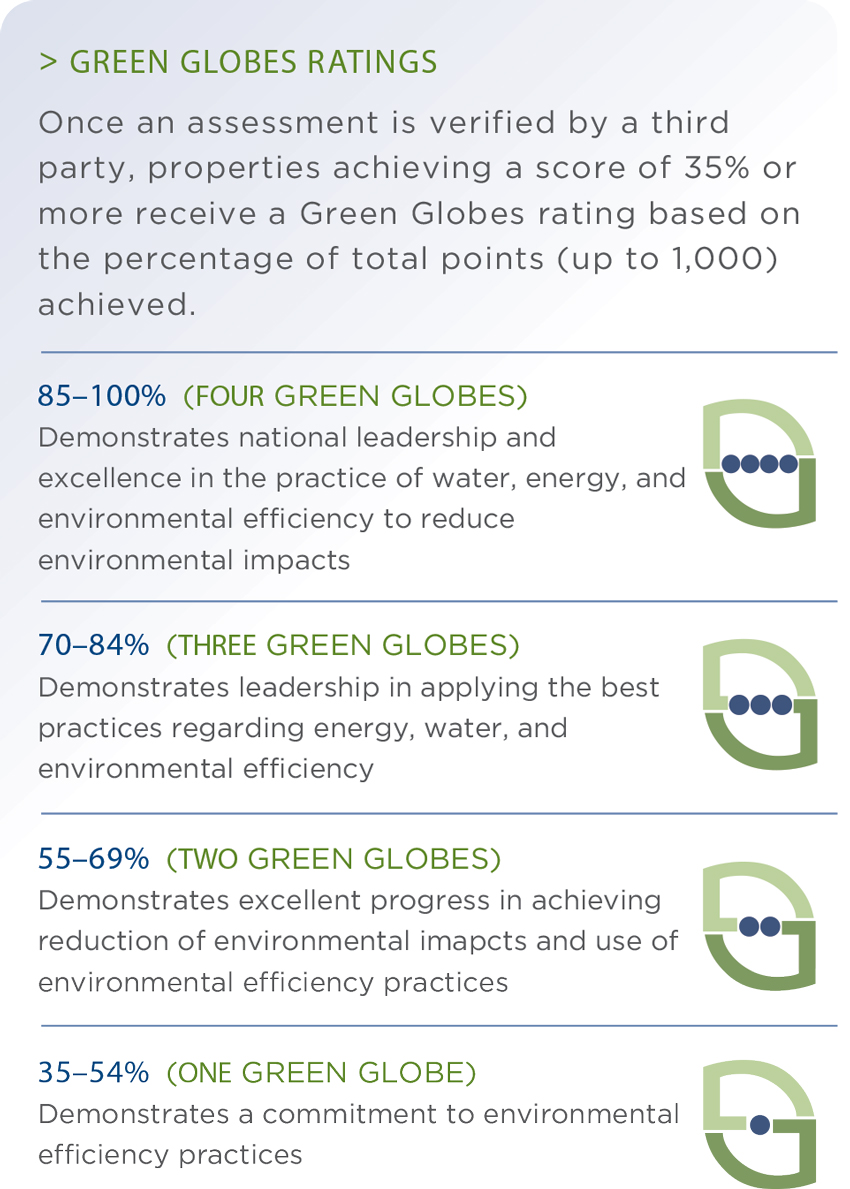Green Globes Certification Overview
The Green Globes Process

© Green Building Initiative
Examination of the Green Globes for New Construction (NC) module facilitates understanding of Green Globes’ unique tool and process. As mentioned previously, the NC program employs a comprehensive evaluation and scoring method based on a 1000-point system. In addition, there are distinct phases within the assessment process, including use of a survey tool to estimate the number of points the building may achieve and completion of a required on-site walk through with the GGA.
The Basics
What are the boundaries? Green Globes NC assessment projects are typically enclosed, permanent, commercial structures with at least 400 square feet of conditioned space that are designed for human occupancy and have been occupied for less than 18 months.
What are the surveys? The New Construction assessment program includes four online, interactive surveys: Pre-Design, Schematic Design, Construction Documents, and Post-Construction.
- The first two surveys, Pre-Design and Schematic Design, are optional and are not scored. They are intended to guide project teams through the design process and help them understand the Green Globes assessment requirements.
- The next two surveys, Construction Documents (CD) and Post-Construction (PC), are identical but are completed at different phases in the construction process (before and after) to track any design changes made during construction. Unlike the optional surveys, the CD and PC surveys are scored and are required as part of the assessment process. The CD and PC surveys each have two versions—one for the client and one for the assessor—so a record of the responses from each party is retained.
What do I do? What does the assessor do? The Green Globes NC assessment process requires two separate stages: 1) a Design Review of the construction documents, and 2) an On-Site Assessment to meet with the project team and tour the completed building.
- A project team lead will need to ensure that the construction documents survey is complete and accurate and provide supporting documents. Using a GGP as team lead is helpful.
- During the Design Review (Stage I), the third-party assessor will review the client’s CD survey responses and verify them using the supporting documentation provided. The assessor will write a comprehensive report that includes a preliminary score, a list of criteria that require additional documentation or visual inspection for verification, and suggested improvements for consideration.
- The On-Site Assessment (Stage II) occurs when construction on the building has reached substantial completion. The assessor will meet with the key project team members to review the Post-Construction survey, collect any documentation that was missing during Stage I, and tour the building. The assessor will then write a detailed report that includes the final Green Globes score and rating as well as recommendations for future improvement.

© Green Building Initiative
Green Globes Assessors visit every building for the on-site assessment.
Scoring Protocols
Green Globes offers four rating levels, which are based on achieving a minimum of 35 percent of applicable points within the 1,000-point system.

© Green Building Initiative
The points are spread over environmental assessment areas, including project management, site, energy, water, materials, emissions, and indoor environment.

© Green Building Initiative
A Few Assessment Area Highlights
Energy
Energy is the most heavily weighted category and aims to accommodate the widest possible range of building occupancy types, sizes, and other considerations. To achieve the maximum score for Energy, the team can follow one of four possible paths for assessing designed (intended) energy performance. These tracks include ENERGY STAR, ASHRAE 90.1, a recently introduced program named ASHRAE bEQ, and the GBI ANSI Standard Path A protocol, which allows the designer to derive a projected energy performance in units of CO2 emissions.
In addition to energy performance, the NC program evaluates prescriptive criteria related to energy efficiency implementation strategies, including space optimization, microclimatic design, energy-efficient equipment, lighting selection and strategy, high-performance building envelope selection, metering and peak load demand efficiencies, and integrating renewable energy.
Indoor Environment
Another heavily weighted assessment area is Indoor Environment. According to the ANSI/GBI 01-2010 standard, indoor environmental quality refers to “the quality of the air and environment inside buildings, based on pollutant concentrations and conditions that can affect the health, comfort and performance of occupants, including temperature, relative humidity, light, sound, and other factors.”4
Therefore, this assessment area provides guidance on how to create healthy interior spaces through proper ventilation, pollutant source control and measurement, daylighting, and thermal and acoustic comfort. Notable features of this section include compliance with updated volatile organic compound (VOC) content thresholds to minimize indoor pollution, assurance that ventilation systems meet ASHRAE 55 2010 standards, and verification that thermal comfort is updated to match ASHRAE90.1 2010.
Project Management
The Project Management area of Green Globes NC emphasizes the importance of planning and coordination in achieving sustainability objectives. The area is divided into five categories: Integrated Design and Management, Environmental Purchasing, Whole Building Commissioning, Environmental Management (including Post-Construction phase), and Emergency Response Planning. This assessment area reflects GBI’s understanding that positive sustainability outcomes are only possible when sound management practices are firmly in place on an institutional level. In addition, Green Globes emphasizes the importance of commissioning to ensure that the building and its systems are operating as intended not only during construction but well into post-construction and over the course of the building’s service life.

© Melvin Mark
The Crown Plaza building in Portland, Oregon, is an office building that earned Four Green Globes for Existing Buildings.









